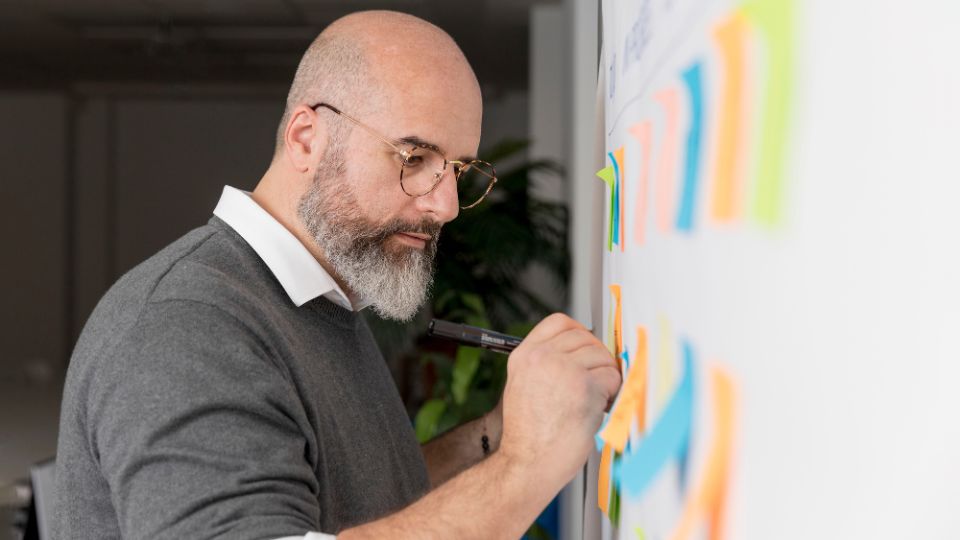
The imminent organizational transformation to which the environment leads us: a journey of natural evolution
Business | Article-
Visit1421
- Febrero 2020
- Date of publication
- Febrero 2020
- Business
- Article

Profesora de ESIC y Coach Ejecutivo de alta dirección y de equipos. Certificación PCC por ICF. Especialista en desarrollo del liderazgo y transformación cultural de las organizaciones.
"
The moment that we are living presents diverse characteristics that confer a unique peculiarity to it as its disturbing novelty, which supposes that we all place ourselves in the same place in front of it, since we assume from the conscious honesty that we do not know, that we do not have reference in which to lean.
Their acceptable equality has impacted the entire human species without economic, territorial or ethnic distinctions. Its global dimensions have meant a complete paralysis of the planet and a common global objective in the face of an invisible and imperceptible enemy. Most importantly, at least for me, for the first time the whole world shares the value of gratitude, compassion, empathy, togetherness and solidarity to the extent possible.
Faced with this striking scenario, I believe that we have a great responsibility to "do something" with what is happening to us so that our cultural model evolves not only in the organizations, but also impacts on a new society and, therefore, in the construction of a new world in which these values are the common and shared language, almost an anthem or a new identity.
It is a unique moment in which the possibilities of learning from the humility of the learner are infinite and allow us to expand our ability to share knowledge, collaborate, generate new experiences and enhance a sense of unity and a shared goal never before seen, because in general terms the world is receptive to the absence of rules or manuals. We have no references, we are free of prejudices, our minds are open to the new and, therefore, this is the best situation to create, innovate and risk.
In 2007 the Lebanese author Nassim Taleb formulated the black swan theory, with which he identified improbable, unusual and unpredictable events that force us to rethink and question our world. Lehman Brothers, the Great Recession or Brexit are faithful examples of his theory. According to Taleb, "the past cannot be used to predict the future" and today, at this very moment, his statement could not be more accurate. We are living in full awareness of what it means in all spheres to go through a black swan of this magnitude: social, economic, political, technological, ethical, personal, demographic, environmental or legal.
The models applied to any past situation are perhaps not applicable to this moment, which is characterized precisely by the evidence of certain paradigms that have reached the point of evolution.
Much has been written about change, its optimized management, its phases and methodologies; however, I believe that we are facing a unique opportunity to carry out an evolution that favors a qualitative or even quantum leap in the direction of organizations and their culture. In the words of John Kotter, "to change the culture, we have to transform the organization" and to do this we must observe everything, starting with the environment.
This is an excellent opportunity to carry out evolutionary and generative changes and leave behind the remedies. If the latter is carried out, after this period, we will surely return to the same reality that was frozen; nothing will have evolved, nothing will have changed and we will continue with our lives, but with an unusual chapter lived to tell the following generations.
Remedial change operates in action-reaction: learning is limited, since its management has an 80% retrospective look (which has worked for me so far) and a 20% present look (stepping on insurance). It focuses on controlling that the same errors do not occur, ignoring the necessary continuous improvement; it is putting a blindfold on oneself to be able to remain in the same place, without taking unnecessary risks and being prepared to react instead of responding.
The generative changes favour the revision of our model of beliefs - which allows us to behave the way we do - and of our model of values - which is truly important and fundamental for us. Many of these paradigms are now being questioned in organizations, and only those organizations that are "awake" and receptive to evolving and adopting a growth mindset will benefit from the many opportunities that these changes bring.
Below are some of the changes that, from my point of view, we can already situate in this moment of transformation:
- Autonomy vs. control: Self-organized and self-managed teams in which the figure of leadership, as we know it, has lost its leading role. The leader determines what and for what, but it is the team that decides how to do it. The value contributed depends on the team.
- Trust vs. control: The reviews focus on verifying the progress of the value contribution process and, therefore, micromanagement already belongs to an obsolete model. There is no point in asking for daily reports, as there is no point in having professionals in the team whom we do not trust or, believe cannot do it.
- Ambition vs. obligation: We have moved from a culture centered on scarcity or error, with high standards of compliance with objectives and where things are done "by royal decree" or "because they have always been done this way", to a culture in which ambition - necessary to create, innovate, think about new horizons and take risks, anticipate errors quickly - is the intrinsic motivation: "fail fast, fail good".
- Talent vs. resources: The value is in the knowledge shared and made available to the team for continuous improvement. There is a feeling of contribution at all levels: towards others, the team, the organization and innovation as a model, among others. There has been a shift from individualistic approaches to shared benefits. The challenge for organisations as a whole must focus on raising the employability of people to enhance their strengths and learning.
- Agility vs. bureaucracy: The procedures help us to develop in a predictable world, in which we can go to the manual that tells us how to solve a complicated problem. We are in a complex world that is characterized by the absence of a script, so it requires agility to provide value and respond to changing demand.
- Commitment vs. obedience: People need to feel proud of belonging to a team or a company or of the quality of leadership that defines them. We need to be excited about our work and feel passionate about tackling complex problems like the ones we have ahead of us.
- Transparency vs. information: It has always been fundamental, but at this time internal, systematic, frequent and detailed communication is key to minimizing the sense of uncertainty in which we find ourselves. The values of honesty and integrity have taken over. It is no longer enough to tell what is happening or to make difficult decisions; it is necessary to have compassion, to take charge of the team's emotions in order to see the world from their eyes. And in the face of difficult decisions, compassionate firmness is practiced.
- Well-being vs. work climate: It is not new to say that the leadership style determines 70% of the emotional climate of the team (Daniel Goleman), so it is no longer enough to develop a style that favours an environment of trust, credibility and empowerment. We know that well-being is holistic and it is necessary to implement aspects that care for people in all their dimensions (body, mind, spirituality and vital energy).
Evolutionary changes lead us to reflections of transcendence and to ask ourselves what mission, what role we want to play in the world. They answer questions such as for whom do we do what we do, who do we want to be? And from here this feeling of contribution is born as a new identity that defines us.
We live in a world in real time, which forces us to surf the emerging reality as events unfold. Our relationship with time, with circumstances, with others and even with ourselves has changed, and inevitably many of the beliefs on which the pillars of management in many organisations have been built have been demolished. What if we took advantage of the environment to evolve in culture and, consequently, to cause an impact on society?
According to the methodology set out in 1995 by John P. Kotter in Leading Change and using some of its precepts, we can analyse the qualitative leaps that we will make in order to approach this new organisation and the culture that we wish to transform:
- Create a sense of urgency. Perhaps we live in an "urgent present" in which it is already late. The present moment is what it is and we must respond immediately. Reality emerges and we try to embrace each moment with our best attitude.
- Create a coalition. Perhaps we need to identify the team members who will be ambassadors of this new way of thinking. The teams have experienced the importance of being united, aligned and collaborating without the presence factor. Even the leadership models have evolved towards itinerancy, co-creation and transversality. We have already evolved from self to us.
- Designing a vision of change. Perhaps as we design the vision of the environment, it has changed again. The era of designing the horizon is part of the recent past. The questions we must ask ourselves are: what do we want to happen, what commitment are we going to have to what we want to happen? Therefore, we need a vision of commitment and coordination of team actions.
- There is no longer a need for constant messages to raise awareness of the benefits of change. There is no need to convince anyone. We are living it in the present moment. We are oriented towards evolution and transformation from honest and transparent communication.
- We can no longer draw a structured and precise road map. We cannot foresee what is going to happen because the world is an unpredictable place. We can respond and be prepared to transform our reality in real time.
- Achievements happen every hour and therefore we need to communicate, measure and be aware of the evolution every moment, every day. We must work from the precepts of agility.
- It is fundamental to continue building the feeling of achievement, of progress, of evolution to strengthen the commitment and the feeling of pride in the team.
- For all the above reasons, I conclude that it is time to question the foundations that have defined the organizational culture. We will hardly have an opportunity like this to rethink our place in the world, our contribution and our value to society: who we are and who we want to be.
It is time to question how we situate ourselves in this ship that sails without a map and to reflect on which principles, systems and processes of people management we have to maintain; which need to be reinforced and which we have to create, as the environment has changed and perhaps we have to be creative to incorporate new rules of the game in terms of leadership styles, management and team leadership. These are moments to explore, discover and above all reflect from the humility of the learner; moments to show our strengths and take advantage of opportunities; moments to evolve towards a new world of possibility and growth. And the best of all is that it is in our hands. Do you dare to change?
"The good thing about crises compared to stable periods is that they show better what we should unlearn”. Albert Camus.
"
You may also be interested in

Customer success: definition and how to implement it
In today's business environment, where competition is fierce and customer expectations continue to grow, customer success has become a key element in ensuring the success of a company's business.
- Published by _ESIC Business & Marketing School

What is the Ishikawa diagram and how to do it. Examples
How many times have we tried to solve a problem by patching it up, without going deep into the real cause, into the root of the problem? There are many companies that, when faced with crises or problems, try to...
- Published by _ESIC Business & Marketing School

JavaScript: what it is, what it is used for and examples
Undoubtedly, JavaScript is one of the most widely used programming languages worldwide. In fact, as early as 2021 it was being used by 14 million programmers according to Genbeta. The trend has been increasing...
- Published by _ESIC Business & Marketing School
